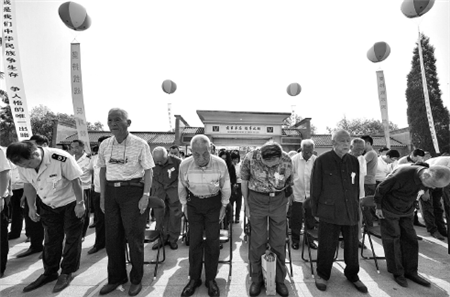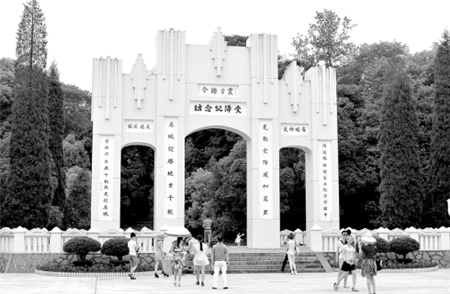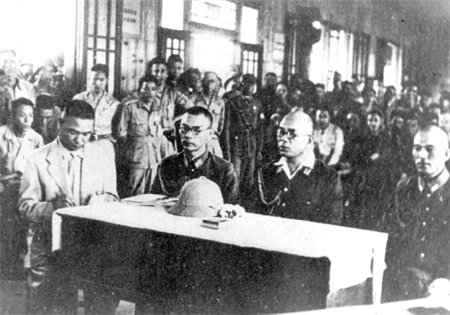A little-known site in Hunan province lays claim to receiving the first formal surrender by the Japanese invaders to China, reports He Na in Zhijiang Dong autonomous county, Hunan.
He Na
On Sept 9, 1945, the commander-in-chief of Japan's China Expeditionary Army, Yasuji Okamura, signed the Japanese Instrument of Surrender in Nanjing.
The historic ceremony marked an end to eight years of Chinese forces fighting the Japanese invaders. The aggressors killed more than 300,000 Chinese during the Nanjing Massacre alone.
But the capital of Jiangsu province was not the first place to receive Japan's formal surrender.
Less than three weeks earlier, on Aug 21, 1945, representatives of the Japanese troops signed a document surrendering to the Chinese people unconditionally.
The ceremony was carried out in the Zhijiang Dong autonomous county in Huaihua, Hunan province. The county was also the site of the last battle between the Chinese army and the Japanese invaders.
"The surrender in Huaihua is special for China, as one of the major battlefields of World War II. Compared with the ceremony on Sept 2, when Japan surrendered to the entire Allied Forces aboard the USS Missouri battleship and the one on Sept 9, the unconditional surrender in Zhijiang might seem more simple. But it is equally important in history, or even more so," said Wu Jianhong, curator of the Memorial Hall for Japan's Surrender in the county.
After the Japanese government declared its unconditional surrender on Aug 15, 1945, both leaders of the Communist Party of China and the Kuomintang urged Yasuji Okamura to surrender to China formally. On Aug 18, the Kuomintang government designated Zhijiang as the first place in the country to receive Japan's surrender.
Okamura told Japanese vice-general secretary Takeo Imai to lead a surrender delegation to Zhijiang on Aug 21. He signed the document marking the success of the War of Resistance against Japanese Aggression, Wu said.
"It marked the first time in modern times that Japan was presented as the loser in the war, begging for China's orders. It was also the first time that high military representatives of the two countries held a formal meeting since the breakout of the War of Resistance against Japanese Aggression in 1937," he said.
The move put Zhijiang under the spotlight at home and abroad. Its Memorial Hall for Japan's Surrender has been opened to the public since 1985.
Central role
Zhijiang is located at the center of the western part of Hunan, close to the border with Guizhou province.
The transport hub had also functioned as an important military fortress.
Home to the second-largest airport in the Far East of the Allied forces, the county's well-equipped airport could provide adequate cover for various planes.
Zhijiang was also the base for US General Clair Chennault's air force unit, the "Flying Tigers", which helped resist the Japanese invaders during World War II. A memorial to the unit is also in Zhijiang.
About 3.5 km out of the county to the west lies a stone bridge called the Qili Bridge, which means "3.5 km". A deep carving on the stone tablet at the head of the bridge reads "the place of the Japanese military surrender".
A tall memorial archway across the bridge is known as "China's archway of triumph". The Zhijiang Memorial Archway for Accepting the Surrender was built in 1946 with white stones and an image of the word "xue", or "blood".
About 50 meters north of the gate lies a row of black, single-storey wooden houses.
"That was where Japanese representatives signed the surrender document. The room has been well-preserved with everything kept in the original condition even after 69 years," said Song Meijiao, vice-director of the memorial's publicity office.
Surrender process
Japanese vice-general secretary Takeo Imai led a delegation of eight people and landed at Zhijiang Airport before noon on Aug 21, 1945. Before arriving at the site of the surrender ceremony, they drove around in three green jeeps with white flags to show their sincere apologies, Song said.
The Japanese aggressors' surrender was eagerly anticipated on the site. Military personnel and reporters filled the seats and people packed the rooms for a glimpse of the historic moment.
Photos exhibited at the Memorial Hall showed how the Japanese representatives were incessantly wiping sweat when faced with so many people during the ceremony.
One of them was Japanese infantry adviser Yoshio Hashijima, who handed over the military deployment map of the Japanese army as part of the ceremony, which was hosted by Chinese army chief of staff Xiao Yisu.
Japan had to refer to Germany's surrender because it did not have any experience in the ceremony, Wu said.
"The ceremony took about an hour, but the Japanese delegation also received detailed surrender instructions, including the arrangement of the 16 surrender regions, locations of the 100 sites where the Japanese military handed over weapons to the Chinese side proposed by Chinese general He Yingqin, and finalized various kinds of requirements of the surrender," he said.
From the time the Japanese delegation landed at Zhijiang Airport till their departure, the 52 hours fully prepared the Chinese armies nationwide for accepting Japan's surrender. It is an important and indispensable part of the World War II victory, he said.
"The site of the surrender is the only landmark in China to commemorate the War of Resistance against Japanese Aggression and World War II victories. It serves as a patriotic event binding Hong Kong, Macao, Taiwan and overseas Chinese to the mainland," said Wu.
Many consider the War of Resistance against Japanese Aggression as the first complete victory for Chinese people in the past century.
"While the Kuomintang government had received Japan's surrender on behalf of China in Zhijiang, that does not mean that the Communist Party of China and the anti-Japanese forces under the Party that fought at the enemy's rear, such as the guerilla attacks, did not contribute to the war effort," said Ma Zhendu, vice-curator of the Second Historical Archives of China.
"It is the joint efforts of both the Communist Party and the Kuomintang that effectively defeated the Japanese army. During the eight years of the War of Resistance against Japanese Aggression, the army led by the Communist Party had been involved in about 125,000 battles with the Japanese army and fought off more than 1.7 million Japanese invaders and forces of the puppet Chinese army. That proves that the Communist Party and its armies were pillars in winning the war," Ma said.
"The Chinese people had suffered tremendously in the war. The total number of China's military and civilian casualties hit 35 million. There is no doubt that the Chinese people made huge contributions to the victory of the world's anti-fascist war.
"In commemorating the role of Zhijiang in the war, we are also reminding the world to be alert to any threats of militarism and to cherish peace."
Contact the writer at hena@chinadaily.com.cn

CHENG TINGTING/XINHUA
Veterans of the War of Resistance against Japanese Aggression remember the victims and soldiers who died during the war at the Memorial Hall for Japan's Surrender in the Zhijiang Dong autonomous county, Hunan province, in September 2013.

BAI YU/XINHUA
Tourists in front of the archway that commemorates the victory of the War of Resistance against Japanese Aggression on Aug 7. The archway was built in 1946.

CHINA DAILY
Japanese representatives stamp a document surrendering to the Chinese people in August 1945.
 PAN XU/XINHUA
A guide on Sunday introduces college students to the site where representatives of the Japanese troops signed a document surrendering to the Chinese people in Zhijiang.
PAN XU/XINHUA
A guide on Sunday introduces college students to the site where representatives of the Japanese troops signed a document surrendering to the Chinese people in Zhijiang.

CHINA DAILY
Japanese representatives during the surrender ceremony to the Chinese people in August 1945.